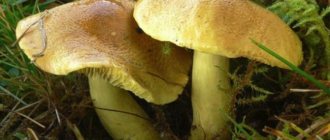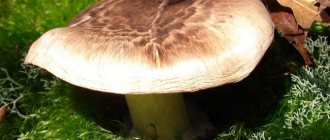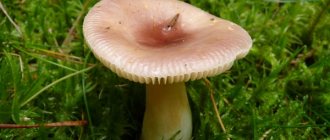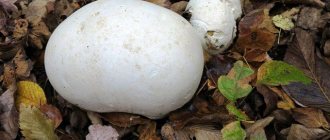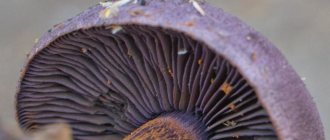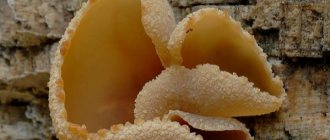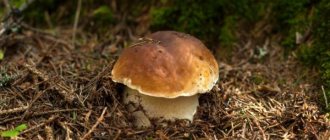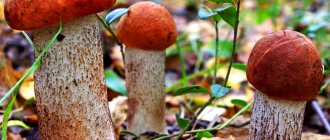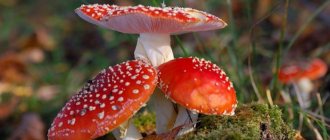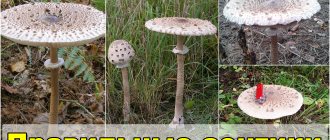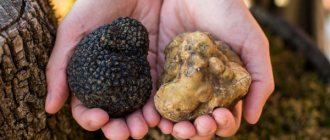Collection rules
It is recommended to collect elm hypsisigus in mid-autumn from the second ten days of September until frost.
You need to look for edible mushrooms in forests at the roots of trees or directly on old stumps and dead wood. Since the elm row usually grows in groups, you can collect a fairly large harvest of mushrooms in one trip. Like all mushrooms, hypsizygus has the ability to absorb toxic substances from soil, wood and air. It needs to be collected only in clean places; you cannot cut fruit bodies growing near roads and industrial areas. Even after processing, too many harmful compounds will remain in their pulp.
How to distinguish May row
May row, which grows in a country house or in a garden, is similar in appearance to the white variety, the cap of which in young specimens is rounded and convex, and becomes flat with age. Poisonous white grass has a pungent taste and a sharp, unpleasant odor. It grows from August to the end of October.
The stinking row is inedible and can cause hallucinations, so it is not eaten. The fruit body has compacted pulp and a convex white cap. Emits a pungent smell of lamp gas. The variety bears fruit in the fall, in September-October. On the territory of Russia it grows only in the Amur region, but in Europe it is found everywhere.
As mentioned above, during the spring harvest, it is impossible to confuse the May mushroom with other members of the family, since they all bear fruit in the fall. However, the May row sometimes appears in September, continuing its growing season. During autumn mushroom hunting, you should pay maximum attention. The main differences between inedible and poisonous rows are an unpleasant, pungent odor and pungent taste. Over time, their caps acquire a flat shape, which is not typical for May calocybe.
hat
The cap is from 5 to 8 cm in diameter, but there are quite large specimens - 15 cm. At first it is distinguished by its convexity and tuberculation. The edge of the cap is curled up, and watery brown spots are visible over the entire surface. Further, the shape changes, becoming convex-prostrate, or prostrate, sometimes there is a blunt tubercle or a slight depression. Some caps come across are eccentric, with drooping edges and drops of liquid hanging from the plate, lingering at the edges in damp, humid weather. It is painted in yellowish “marbled”, watery spots, sometimes whitish, fawn, slightly yellow, and there are specimens in a pale whitish-brown color.
Description
Hypsizygus elm has a characteristic pattern on its cap that no other mushroom has. These fungi grow in large clusters on woody substrates.
hat
Shape: when young, distinctly convex with a tucked edge, becoming unfolded as it matures. The cap is thick and fleshy. Quite large, usually around 10 cm, but can reach 25.
Color: from white to light beige with a specific marble pattern formed by darker spots resembling drops of water or molten wax.
Dry, velvety.
Leg
Shape: often curved, thickens at the bottom, merges with the legs of neighboring specimens, forming large associations. In mature specimens, a cavity may form inside.
Size: short and relatively thick (approximately 8*2 cm in length and diameter, respectively).
Color: slightly lighter than the cap.
Surface: smooth, pubescence may be observed downwards.
Type: lamellar.
Color: slightly lighter than the cap.
Features: jaggedly adherent, frequent, moderate thickness.
Pulp
Density: dense and elastic, even hard.
Color: white, turns yellow when damaged mechanically.
Organoleptic characteristics: pleasant mushroom taste, typical “ordinary” smell, mealy with notes of dampness.
Growing at home
Elm row belongs to the category of mushrooms that are not only collected in the forest, but also grown at home or in the country. This is quite simple to do - you just need to prepare the hypsizygus mycelium, as well as get a good and healthy deciduous log. Mushrooms can be grown indoors throughout the year; in the country, planting should be done from April to October.
The elm row is prepared for planting as follows:
- A birch, aspen or elm log is selected as a nutrient substrate; it should be about 30 cm in diameter and about 50 cm in length. The tree must be taken young, but not younger than 4 years old; the log should not show signs of rotting, branches or any other or defects.
- The log is kept in water for 3 days so that the wood reaches the desired moisture level. After the expiration of the period, the tree is moved to a dry and well-ventilated place for 3-5 days so that excess water comes out of it.
- Using a drill, small indentations about 5-10 cm deep are made in the log, placing them in a checkerboard pattern at intervals.
- The prepared mycelium is placed into the drilled holes using thin, clean sticks. To avoid infecting the hypsizygus seeds with bacteria, sowing should be done with gloves, and the log should be covered with plastic bags immediately after planting the mycelium.
A moistened log with elm row seeds sown inside is transferred to a shaded, well-ventilated place with a constant temperature of at least 20 ° C. While the mycelium develops, the log needs to be moistened from time to time so that the nutrient medium for hypsizygus is maintained.
The development of the elm row mycelium takes about 3 months, sometimes more or less. The first harvest can be seen six months after planting.
Of course, an elm row at home will not be able to grow on the same log for a long time. Soft logs taken from birch, willow or poplar feed the mycelium for about 4 years; on maple, beech and rowan logs the row can grow for up to 7 years. After the yields are reduced, the procedure for planting mushroom seeds will need to be repeated.
Attention! Growing elm row yourself allows you not to look for it in the forest, but to collect it in abundance every year right at home. One small log gives a generous harvest of up to 6 kg per season
How to grow mushrooms at home
Growing oyster mushrooms at home requires a careful approach. To do this, you need to know and strictly follow a certain technology, otherwise your efforts will not be successful. But it is worth considering that such mushrooms feel best underground, so it is recommended to prepare a basement or cellar for their cultivation.
The soil
Like champignons, you need to grow oyster mushrooms at home on a special substrate:
- dry straw;
- sunflower seed husks;
- sawdust made from wood of deciduous trees;
- corn stalks;
- reeds.
Tip! If one component is not enough for growing oyster mushrooms, you can mix several of them. The main condition is that the soil must be dry.
The selected material must be crushed. The fractions of the raw material should be about 0.4 cm. The substrate must be placed in a barrel, pour boiling water over it and wait until it swells. After this, remove it and let it dry completely.
Description of the mushroom
Hypsizygus elm (lat. Hypsizygus ulmarius Lyophyllum ulmarium) is an edible mushroom originating from the genus Hypsizygus. Belongs to the department Basidiomycetes, class Agaricomycetes. It is also known by the names Ryadovka elm, Lyophyllum elm.
The diameter of the mushroom cap is 5–10 cm. It looks fleshy and convex. In young oyster mushrooms, the edge is strongly bent, becoming flatter with age. The cap is white (like the plates), with watery spots visible on top.
The leg is 5–8 cm in height (rarely 10 cm), widens towards the base, curved. Fibrous, has a whitish coating on top, which turns yellow after touching.
Fruit body with elastic, grayish dense pulp. Fresh oyster mushrooms have a pleasant, damp smell.
A little history
The mushroom was first discovered in the Far East. It got its name because of its bright color. Elm - because it can often be found on elm (Far Eastern elm).
https://youtube.com/watch?v=qLWWH8m-1J4%3F
Interesting Facts
Lyophyllum elm.
- This mushroom received the specific name “elm” because, according to some sources, it was first discovered growing on elm - the Far Eastern elm. Hypsizygus elm is also considered an oyster mushroom (its other name is “elm oyster mushroom”). Oyster mushrooms are grown under artificial conditions, on a sawdust substrate. This mushroom is of industrial importance due to its high yield, and it grows in large clumps.
- Hypsizygus elm has medicinal properties. It contains a huge amount of vitamins and microelements (vitamins B, D, iron, copper, potassium, etc.), as well as fiber. These mushrooms can be used in the complex treatment of diabetes, bronchial asthma, anemia, etc. But even such a valuable product has contraindications: people with chronic digestive problems, children, pregnant and lactating women should not eat mushrooms.
Smoky gray lyophyllum, Lyophyllum fumosum
Hat:
From convex, cushion-shaped to flat in maturity, often, in accordance with growing conditions, irregular in shape, with wavy, intricately curved edges. Due to the same conditions, there is a large variation in size; within one fusion, the diameter of the cap can vary from one to seven centimeters. The color is dirty gray, smoky or matte, from which Lyophyllum fumosum deserves its name. The surface is smooth, dry, sometimes covered with small scales washed away by precipitation. The pulp is grayish, moderately elastic, with a weak mushroom smell, without much taste.
Hymenophore:
The plates are attached to the teeth, relatively wide and frequent, in young mushrooms they are light cream, and later turn gray.
Spore powder:
White.
Leg:
Smoky lyophyllum bears fruit in large clumps (single specimens are rare), where stems of different lengths, thicknesses and curvatures form a monolithic “tuber”. The legs are painted predominantly in light colors with a predominance of different shades of gray; the surface is smooth, with a powdery coating in dry weather. The flesh of the leg is light, highly fibrous.
Spreading:
Lyophyllum smoky-gray is found in dry pine forests, forming mycorrhizae, respectively, with double-crowned pine, from mid-summer to October. This mushroom is not common every year, but in good seasons Lyophyllum fumosum can bear fruit surprisingly abundantly, even forming “witch rings” of massive clumps.
Similar species:
According to the views of the science of mycology, Lyophyllum fumosum is part of a complex of “fused” lyophyllums, differing only in the growing conditions and mycorrhiza-forming agent. In this row we can distinguish the fused row, Lyophyllum connatum, and the crowded row, Lyophyllum decastes. On what basis some species of the genus Lyophyllum in the Russian adaptation remain “lyophyllums”, while others turn into “rows”, is unknown to science.
Edibility:
Unlike other “allied” lyophyllums, Lyophyllum fumosum is considered a very good edible mushroom, which is obviously due to its not so hard pulp. However, due to the fact that it grows in the most abundant places, it is rarely collected.
Author's notes:
On the dry sand, among sparse moss and stunted pines, lush thickets of smoky lyophyllum produce some kind of suspicious impression. And, it’s true, not only for me. Hunters of saffron milk caps and boletus find a clearing densely overgrown with these strange mushrooms, pick off a splice or two, pick at it, and throw it away. Tell them that this is a quite decent mushroom to prepare, they won’t believe it and, perhaps, will be offended. It turns out that all the work was in vain.
Fragment of the “great mushroom shaft”. The entire shaft that crossed the clearing between the pine plantations has not been preserved. Once it was continuous, almost monolithic, but the invasion of the horde of boletus hunters could not be stopped.
Just that rare moment when the photographer does not feel guilty for damaging the plantings. Someone curious, and not alone, managed to, so to speak, prepare the drug for research. I believe that people who tear and throw away mushrooms they don’t need are driven by some high feeling. Let them not know it themselves.
Lyophyllum elm
It is also grown in the temperate climates of Europe, North America, and Australia. There are two varieties of the mushroom: with white and brown fruiting bodies. The mushroom pulp is bitter, but the bitterness goes away when cooked. Ready shimeji has a crunchy texture and a nutty flavor.
An edible mushroom that looks like elm lyophyllum. Its cap is brown; in mature mushrooms it cracks. The shape of the cap is round, the surface is dry. The pulp is white. The leg is long, club-shaped. Mycorrhiza forms with fir, oak and pine trees.
Search form
Fruits from September to October. Thanks to the characteristic watery-waxy spots on the cap, elm lyophyllum differs from other types of mushrooms, and similar inedible or poisonous species have not been described for it. At home, elm lyophyllum is grown from mycelium.
To plant it, logs of birch, elm, elm, and aspen are prepared that are at least 5 years old, about 30 cm in diameter, and about 0.5 m in length. The logs must be free of branches, rot and other defects. Favorable period for sowing mushrooms: from April to October. The logs are soaked in water for days until the desired moisture level is achieved.
Briefly about the main thing
After removing the logs from the water, excess liquid is removed from them by keeping them for several days in a well-ventilated area. In the logs prepared in this way, small holes 1 cm in diameter and cm deep are drilled with a drill.
They are placed in a checkerboard pattern at a distance of 20 cm from each other. Then, with cleanly washed hands or wearing gloves, special sticks with mycelium are placed into these holes. Next, the logs are packaged in plastic bags, which prevents them from becoming infected and accelerates the development and growth of the mycelium.
During the entire period of development of the mycelium, the moisture content of the logs is monitored. After a month, the mycelium completely fills the substrate. And six months later the first harvest appears.
The fruiting time depends on the hardness of the logs. For example, on soft trees, poplar, willow or birch, mushrooms are collected for about four years. Hard varieties such as maple, rowan, and beech bear fruit for years.
About edibility
It would be unfair to call the soap bark frankly poisonous. It is almost impossible to be poisoned to death by it. But the mushroom has an unpleasant feature: it smells distinctly and brightly of laundry soap. Even those from Soviet times. That is why the soap row is considered inedible. There is still a recipe for its preparation: cook only with other, more pleasant gifts of the forest, add small quantities to a common pile, and before salting, cook in three or four waters, mercilessly draining them.
However, this doesn't help much. The soapy “aroma” is too persistent. Some mushroom pickers are even sure that it only intensifies when cooked.
In addition, there is information that the pulp itself tastes bitter. It is partially eliminated during cooking. But accompanied by a distinct aroma, eating mushrooms still does not bring pleasure.
Elm row (elm hypsizygus): what it looks like, where it grows, is it possible to eat
Hypsizygus ulmarius, Elm lyophyllum, Elm oyster mushroom (Hypsizygus ulmarius (Bull.) Redhead, 1984)
Insert-tree-mushroom Synonyms: Agaricus ulmarius Bull., 1791Pleuropus ulmarius (Bull.) Gray, 1821Pleuropus ulmarius (Bull.) Gray, 1821Pleurotus ulmarius (Bull.) P. Kumm., 1871Dendrosarcus ulmarius (Bull.) Kuntze, 1898Micromphale ulmarium ( Bull.) Murrill, 1916Hypsizygus ulmarius (Bull.) Redhead, 1984
Etymology: Lyophyllum (Greek lyo - dissolve, destroy; Greek phyllis - leaf) ulmarium (Latin ulmarium - elm).
Cap: up to 20 cm or more in diameter, convex, then prostrate, with a straight or drooping edge, often fissured, especially with age, almost white or ocher-, flared-, grayish-brownish.
Laminae: adherent or slightly descending, wide, frequent, rather thick, white or light yellowish.
Leg: 4-10 x 1.5-2.5 cm, often eccentric, cylindrical, solid, longitudinally fibrous, whitish
Pulp: thick, dense, white, sour, with a floury smell.
Spores: 5-6 x 4 µm, spherical or broadly ovoid, smooth.
Spore powder: white.
Habitat: grows on living trunks, dead wood and stumps of deciduous trees in forests and parks.
Season: Fruits from August to October.
Edibility: Medium quality edible mushroom.
Distribution in Kazakhstan: found at the base of a living birch near Lake Zhukey in the Akmola region.
Area: Russia, Belarus, West. Europe, East Asia, North America.
Hypsizygus elm in photographs:
Links
- Elm lyophyllum on the website [mycoweb.narod.ru/fungi/Hypsizygus_ulmarius.html “Mushrooms of the Kaluga Region”].
- Elm lyophyllum on the website [www.toadstool.ru/spisok-rodov/lyophyllum/lyophyllum-ulmarium/ “We, mushrooms”].
- Elm lyophyllum on the website [wikigrib.ru/liofillum-ilmovyj/ “Wikigrib”].
- Elm lyophyllum on the website [ya-gribnik.ru/syedobnye-griby/liofillum-ilmovuy.php “I am a mushroom picker”].
- Lyophyllum elm on the website [www.rogersmushrooms.com/gallery/DisplayBlock~bid~6211~source~gallerychooserresult.asp RogersMushrooms].
Description of Hypsizygus elm
The diameter of the cap varies from 5 to 8 centimeters, but there are quite large specimens whose cap diameter reaches 15 centimeters. Young mushrooms have convex caps with rolled edges. Droplets of moisture collect at the edges.
With age, the shape of the cap becomes convex and spread, sometimes there is a blunt tubercle or, conversely, a small depression. The cap is whitish, slightly yellowish, fawn with marbled, watery spots, and some specimens are pale brown in color.
The length of the leg is 5-8 centimeters, sometimes it can grow up to 10 centimeters, its diameter is 1-1.5 centimeters. The leg is most often central, sometimes it is curved, and at the base it is widened. The structure of the leg is longitudinally fibrous. Some mushrooms have pubescence at the base of the stem.
The leg is hollow inside. The color is whitish or pale fawn with a slight coating. If you touch the leg, it turns yellow.
The pulp is elastic, watery, grayish or slightly yellowish in color. The pulp has a damp smell. The spores are elliptical or spherical in shape.
Places where Hypsizygus elm grows
These mushrooms grow in deciduous and mixed forests. They can be found in early autumn and until the second half of October. Harvest time is in September. They grow in bunches or singly.
Hypsizygus elm is a parasitic fungus; it causes white rot in deciduous trees on the roots of which it grows. These fungi parasitize on birch, elm, aspen, and can also be found on stumps.
Elm hypsizigus are unable to carry out the synthesis of organic substances themselves, since they are a heterotrophic species. They receive carbon from the roots of higher plants, thus replenishing their vitality.
Taste qualities of Hypsizygus elm
Hypsizygus elm is not very well known in our country. This mushroom has a rather average taste. They can be used fresh, pickled and salted, but they must first be boiled for 20 minutes. It is allowed to add these mushrooms fresh as an addition to main courses. They can be pickled and salted. The flesh of the legs is fibrous-rubber.
Elm hypsizigus goes well with fish and meat dishes. When fried in butter they become very tasty.
Medicinal properties of Hypsizygus elm
These mushrooms have excellent medicinal properties. They contain a balanced amount of copper, iron, vitamins B2, D, potassium and pantothenic acid. Hypsizygus elm contains a large amount of fiber, so these mushrooms can be used in various diets and to improve metabolism.
Hypsizygus elm is used in the treatment of asthma, diabetes, anemia. They stabilize blood pressure and normalize the functioning of the cardiovascular system. They improve immunity, they create a barrier against viruses, fungi, bacteria and carcinogenic effects.
Evaluation of taste qualities, medicinal properties, benefits and possible harm
Oyster mushroom is an edible mushroom. Taste qualities are rated 4 out of 5. It is not recommended to consume in large quantities. Excessive consumption may cause a feeling of heaviness in the stomach.
Elm lyophyllum has medicinal properties. The fruiting bodies contain mineral salts, vitamins, and 18 amino acids. The enzymes amylase and lipase contained in mushrooms help reduce weight and break down fats. Saturate the human body with fiber and glycogen.
Oyster mushrooms are an effective remedy against stomach ulcers. The juice is squeezed out of the mushrooms and a few tablespoons are given to the patient on an empty stomach. The same treatment is carried out for gastritis. Row juice improves peristalsis, heals wounds, and relieves inflammation.
Use
Edible forest mushroom is very popular in cooking. A variety of recipes suggest using hypsizygus in salads and soups, main courses and side dishes, and in baking fillings. Elm rows are also pickled and salted, this allows them to preserve their beneficial properties for a long time.
Before any preparation, hypsizygus must be additionally prepared for use. Fresh caps are cleaned, washed in cold water and boiled for at least 20 minutes; processing helps improve taste.
Advice! It is better to cut elm rows with wide caps into small pieces before processing. Small fruiting bodies can be boiled whole.
How to prepare crowded rows
This species is classified as conditionally edible, so it is allowed to be consumed only after heat treatment. Be sure to boil the mushrooms for 15 minutes in clean water. Thus, all hazardous substances are destroyed.
Recipe for making crowded row:
- Clean, rinse under running water.
- Place in a container and add salt.
- Cook for 40 minutes over medium heat.
- Strain.
- Add vegetable oil, onion, cut into half rings.
This species can also be salted, fried, pickled, like other edible plate varieties. The taste of the row is often compared to oyster mushrooms.
Lyophyllum shimeji
Hon-shimeji
Until recently, it was believed that Lyophyllum shimeji was distributed only in a limited area covering the pine forests of Japan and parts of the Far East. At the same time, there was a separate species, Lyophyllum fumosum (L. smoky-gray), associated with forests, especially conifers; some sources even described it as a mycorrhiza-former with pine or spruce, outwardly very similar to L.decastes and L.shimeji. Recent molecular studies have shown that no such distinct species exists, and all records classified as L.fumosum are either specimens of L.decastes (more common) or L.shimeji (less common). in pine forests). Thus, today (2018), the species L.fumosum has been abolished, and is considered a synonym of L.decastes, significantly expanding the latter’s growing areas, almost to “anywhere”. Well, L.shimeji, as it turned out, grows not only in Japan and the Far East, but is widespread throughout the boreal zone from Scandinavia to Japan, and, in places, is found in pine forests of the temperate climate zone. It differs from L.decastes only in larger fruiting bodies with thicker legs, growth in small clumps or separately, attachment to dry pine forests, and at the molecular level.
Description
Hat: 4 - 7 centimeters. In youth it is convex, with a distinctly curved edge. With age, it evens out, becomes slightly convex or almost prostrate; a pronounced wide, low tubercle almost always remains in the center of the cap. The skin of the cap is slightly matte and smooth. The color range is in gray and brownish tones, from light grayish-brown to dirty gray, and can acquire yellowish-gray shades. Dark hygrophanic spots and radial stripes are often clearly visible on the cap; sometimes there may be a fine hygrophanic pattern in the form of a “net”.
Plates: frequent, narrow. Loose or slightly grown. Young specimens are white, later darkening to beige or grayish.
Leg: 3 - 5 centimeters in height and up to one and a half centimeters in diameter, cylindrical. White or greyish. The surface is smooth, may be silky or fibrous to the touch. In adhesions formed by mushrooms, the legs are firmly attached to each other.
Ring, cover, Volva: missing.
Pulp: dense, white, slightly grayish at the stem, elastic. Does not change color when cut or broken.
Smell and taste: pleasant, slightly nutty taste.
Spore powder: white. Spores: from round to broadly ellipsoid. Smooth, colorless, hyaline or with fine-grained intracellular contents, weakly amyloid. With a large variation in size, 5.2 – 7.4 x 5.0 – 6.5 microns.
Season and distribution
Active fruiting occurs in August - September. Lyophyllum shimeji grows in small clumps and groups, less often singly. Distributed throughout Eurasia from the Japanese archipelago to Scandinavia.
Similar types and differences from them
Lyophyllum decastes also grows in clumps, but these clumps consist of a much larger number of fruiting bodies. Prefers deciduous forests. The fruiting period is from July to October. Elm lyophyllum (elm oyster mushroom, Hypsizygus ulmarius) is also considered very similar in appearance due to the presence of hygrophanic round spots on the cap. Oyster mushroom has fruiting bodies with a more elongated stalk and the color of the cap is generally lighter than that of Lyophyllum shimeji
However, these external differences are not so fundamental if you pay attention to the environment. Oyster mushroom does not grow on soil, it grows exclusively on dead wood of deciduous trees: on stumps and remains of wood immersed in the soil
Other information about the mushroom
The species name "Shimeji" comes from the Japanese species name Hon-shimeji or Hon-shimejitake. But in fact, in Japan under the name “Shimeji” you can find on sale not only Lyophyllum shimeji, but also, for example, another lyophyllum, elm, actively cultivated there.
Photo of Lyophyllum shimeji
from questions in recognition:
Elm oyster mushroom (Hypsizygus ulmarius)
Current title
| Index Fungorum | Hypsizygus ulmarius (Bull.) Redhead |
| MycoBank | Hypsizygus ulmarius (Bulliard) Redhead |
Systematic position
Fungi, Basidiomycota, Agaricomycetes, Agaricales, Lyophyllaceae, Hypsizygus
Etymology of the specific epithet
Ulmarius, a, um, elm, elm. From ulmus, i, m, elm + -arius, a, um, relation. Also Ulmus, Elm (genus name).
Synonyms
- Agaricus ulmarius Bull., Herb. Fr. (Paris) 11: tab. 510 (1791)
- Pleuropus ulmarius (Bull.) Gray, Nat. Arr. Brit. Pl. (London) 1:615 (1821)
- Pleurotus ulmarius (Bull.) P. Kumm., Führ. Pilzk. (Zerbst): 105 (1871)
- Dendrosarcus ulmarius (Bull.) Kuntze, Revis. gen. pl. (Leipzig) 3(2): 464 (1898)
- Micromphale ulmarium (Bull.) Murrill, N. Amer. Fl. (New York) 9(5): 307 (1916)
- Lyophyllum ulmarium (Bull.) Kühner, Contribution a l'Etude de Quelques Aspergilles 7: 211 (1938)
- Dendrosarcus coriipellis (Fr.) Kuntze, Revis. gen. pl. (Leipzig) 3(2): 463 (1898)
Other names: Elm lyophyllum.
Habit
- Fruiting body: Cap and stalk (agaricoid)
- Hymenophore: Lamellar (including folded or with vestigial plates)
hat
Cap with a diameter of 50 - 80 (150) mm, at first convex, with a curled edge, hygrophanic with numerous round watery brownish spots, then convex-prostrate, prostrate, sometimes with a blunt tubercle or slightly depressed, sometimes eccentric, with a bent edge, often with drops liquid on the plates or along the edges is generally quite light: whitish, fawn, brownish-gray.
The plates are frequent, wide, widely grown, white or yellowish.
Leg
Leg 50 – 80 (100) mm long, 10 – 15 mm in diameter, central or slightly eccentric, sometimes curved, widened towards the base, slightly swollen, longitudinally fibrous, sometimes pubescent at the base, made inside or with a cavity, whitish, pale fawn, with a whitish coating, turns yellow when touched.
Pulp
The pulp is very dense, elastic, fibrous in the stem, watery, grayish or yellowish, with a damp smell.
Microscopy
Spores are 4 – 6 × 5 – 6 µm, almost spherical or broadly ellipsoid, hyaline, non-amyloid, cyanophilic [1].
Basidia 18 – 25 × 4.5 – 6 µm, club-shaped, with a clearly visible central constriction, 2- and 4-spores, with a buckle at the base; cytoplasm with siderophilic granules [1].
Cystids are absent [1].
Pileipellis consists of cylindrical hyaline hyphae with buckles, 4–8 μm in diameter [1].
Hyphae 2 – 8 µm in diameter, with buckles; in the mediostratum the plates are parallel located, in the subhymenium rather irregularly located, densely packed, thin-walled, inlaid, 2 – 4 µm in diameter; in the pulp with slightly thickened walls, 4 – 8 microns in diameter, freely located.
Ecology and distribution
- Substrate: Woody plants (living trees, bark and dead wood)
- Substrate: Soil, litter
In deciduous and mixed forests, parks, on stumps, dead wood and at the base of living deciduous trees (aspen, birch, elm), in small clumps, less often singly, infrequently.
In Western Siberia, it is recorded in the vicinity of Akademgorodok, where it is sometimes found on aspen and birch wood.
Fruiting
From early September to mid October.
JanFebMarAprMayJun
JulAugSepOctNoveDec
The divisions correspond to the ten days of the month.
Nutritional properties
- Edible
Similar species
- Crowded lyophyllum (Lyophyllum decastes) is distinguished by its growth in larger clumps not on wood, but on the soil, and the absence of pronounced watery spots on the cap. Two similar and related species of lyophyllum - smoky-gray lyophyllum L. fumosum and hon-shimeji L. shimeji grow on the soil in pine forests.
- Oyster mushroom (Hypsizygus tessulatus) is an outwardly almost indistinguishable species native to East Asia (which in itself does not exclude the possibility of its growth in the forests of Western Siberia). Widely cultivated, known in Japanese cuisine as buna-shimeji.
- Another species, which we have not yet been able to identify, similar to the elm oyster mushroom in habit, elastic white flesh and ecology, is sometimes found on fallen deciduous trees in old-growth mixed taiga forests of the Khanty-Mansi Autonomous Okrug-Yugra. As a rule, this mushroom grows solitarily, is lighter in color, and the base of its stem is distinctly pubescent. One of the samples we collected was very bitter, while others had less pronounced bitterness. Perhaps this is an as yet undescribed species, close to the elm oyster mushroom.
Growing at home and in the country
Growing oyster mushrooms at home is profitable. Mushrooms do well on any deciduous tree (freshly cut). If the wood is soft, then the fruits appear quickly, but the yield is small. Hard rocks will provide a rich harvest, but the mycelium will grow more slowly.
The price of mycelium starts from 2 dollars. Before planting, the trunk is cut into logs (30–40 cm in diameter, 30–35 cm in length). If the bars are smaller than the specified sizes, then fewer mushrooms will be produced. There are several methods of planting, let's consider the simplest and most convenient.
Progress:
- Add mycelium (no more than 100 g) under the base of the bar.
- Bury the logs in the ground, 10–12 cm deep. The distance between them should be from 30 cm to 0.5 m.
- Inoculate in late spring. The harvest can be harvested in the fall.
Taste and color
This mushroom is not well known in our country; its taste is quite average. In order to cook, boil for 15 to 20 minutes. It is allowed to use fresh as an addition to the second course, you can salt and marinate. The legs have a fibrous rubbery flesh. An excellent combination with meat and fish dishes, it acquires excellent taste when fried in butter. It has excellent healing properties, contains the optimal amount of iron, copper, potassium, Vitamins B2, D, pantothenic acid. Due to the fact that it contains a large amount of fiber, it can be used in diets to improve metabolism. Helps in the treatment of anemia, stabilizes blood pressure, treats asthma and diabetes, and stabilizes the cardiovascular system. This mushroom will not only increase the tone of the body, but also create a barrier against viral, bactericidal, fungal and carcinogenic effects, by increasing the function of the immune system.
Use in cooking
Elm lyophyllum does not have high taste qualities, so it is not very popular among gourmets. It can be consumed after any type of heat treatment and can be stored for future use by drying, salting and pickling. For all mushrooms of this type, there is a general cooking rule: after you have thoroughly cleaned and washed the mushrooms from dust and debris, they need to be boiled in salted water for at least 20 minutes.
Julien
Products:
- 500 g chicken meat,
- 2 onions,
- 400 g mushrooms,
- 150–200 g hard cheese,
- spices.
In addition, for the sauce we will need:
- 50 g butter,
- 2 eggs, 2 tbsp. spoons of flour,
- 2 glasses of milk,
- salt and pepper - to taste.
Preparation:
First of all, you need to boil the meat with the addition of salt and bay leaf, and cool. Chop the onion and simmer in butter until golden brown. Place the onion in a separate container, and place the sliced mushrooms in the frying pan and fry them until tender. For the sauce, sauté the flour with butter in a saucepan, pour in the milk and bring the mixture to the consistency of sour cream. After obtaining the desired consistency, remove the sauce from the heat, add the egg, salt and pepper. If desired, you can add a teaspoon of ground nutmeg.
In a deep bowl, mix the chopped fillet, fried onions and mushrooms, and sauce. Place the resulting mixture in special molds - cocotte makers, sprinkle grated cheese on top and bake in the oven for 15 minutes at 180 degrees. Serve immediately after preparation.
Salad with mushrooms
Products:
- 300 g mushrooms,
- 2 boiled eggs,
- 200 g chicken fillet,
- carrot,
- bulb,
- can of canned corn,
- vegetable oil,
- mayonnaise,
- salt and pepper.
Preparation:
Finely chop the onion and grate the carrots. Fry vegetables in oil until tender. Add pre-peeled and boiled mushrooms to them and simmer until the resulting juice has completely evaporated. Remove the mixture from heat and cool. Cut the boiled fillet into small cubes, and do the same with the chicken eggs. In a salad bowl, mix eggs, fillet, mushrooms with vegetables and canned corn, add salt and season with mayonnaise. Before serving, it is advisable to keep the salad in the refrigerator for one and a half to two hours so that the ingredients are well soaked in the sauce.
Mushroom porridge from a slow cooker
Products:
- 2/3 cup each of rice, buckwheat and pearl barley,
- 4 glasses of water,
- 500 g mushrooms,
- 1–2 heads of onions,
- sunflower oil,
- salt to taste.
Preparation:
Fry chopped onions and mushrooms in vegetable oil in the “Fry” mode, set aside. Pour pearl barley, pre-soaked for two hours, into the multicooker bowl. Place washed rice on top of it. The next layer is buckwheat. Pour water over the cereals and turn on the “Milk porridge” or “Stew” mode (depending on the model of the device) for an hour. After this, the porridge needs to be mixed with mushrooms and can be served. This very satisfying and healthy dish is suitable for those who are fasting.
Definitioner
Basidia (Basidia)
Lat. Basidia. A specialized structure of sexual reproduction in fungi, unique to basidiomycetes. Basidia are terminal (end) elements of hyphae of various shapes and sizes, on which spores develop exogenously (outside).
Basidia vary in structure and method of attachment to hyphae.
Based on the position relative to the axis of the hyphae to which they are attached, three types of basidia are distinguished:
Apical basidia are formed from the terminal cell of the hypha and are located parallel to its axis.
Pleurobasidia are formed from lateral processes and are located perpendicular to the axis of the hypha, which continues to grow and can form new processes with basidia.
Subbasidia are formed from a lateral process turned perpendicular to the hyphal axis, which stops growing after the formation of one basidium.
Based on morphology:
Holobasidia are single-celled basidia, not divided by septa (see Fig. A, D).
Phragmobasidia are divided by transverse or vertical septa, usually into four cells (see Fig. B, C).
By type of development:
The heterobasidium consists of two parts - the hypobasidium and the epibasidium developing from it, with septations (see Fig. C, B) or without them (see Fig. D).
Homobasidia is not divided into hypo- and epibasidia and in all cases is considered to be holobasidium (Fig. A).
The basidium is the site of karyogamy, meiosis, and the formation of basidiospores. Homobasidy, as a rule, is not functionally divided, and meiosis follows karyogamy. However, the basidia can be divided into probasidium, the site of karyogamy, and metabasidium, the site of meiosis. Probasidium is often a resting spore, for example in rust fungi. In such cases, the probasidium germinates into a metabasidium, in which meiosis occurs and on which basidiospores are formed (see Fig. E).
See Karyogamy, Meiosis, Hypha.
Pileipellis
Lat. Pileipellis, skin - a differentiated surface layer of the cap of agaricoid basidiomycetes. The structure of the skin in most cases differs from the inner flesh of the cap and may have a different structure. The structural features of pileipellis are often used as diagnostic characters in descriptions of fungal species.
Based on their structure, they are divided into four main types: cutis, trichoderma, hymeniderma and epithelium.
See Agaricoid fungi, Basidiomycete, Cutis, Trichoderma, Hymeniderma, Epithelium.
Amyloid (Amyloid structure)
The structure is called amyloid if the Meltzer reagent (solution of 0.5 g of crystalline iodine + 1.5 g of potassium iodide + 20 ml of chloral hydrate + 20 ml of distilled water) turns blue, violet, and sometimes almost black.
See Dextrinoid structure.
